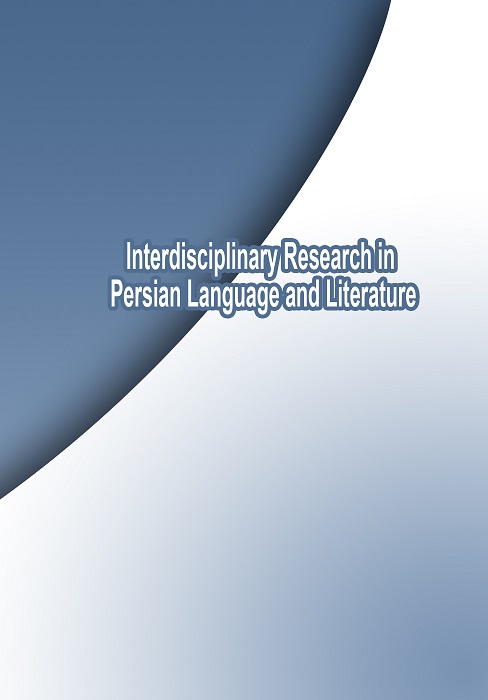Transactional analysis of Jamshid in Ferdowsi's Shahnameh Based on the theory of Eric Burn
Document Type : Research Paper
Author
Faculty of Persian Language and Literature Department of Arak University
Abstract
Transactional Analysis (TA) Theory provides a comprehensive psychological model for examining interpersonal dynamics and personality structures, positing that individuals embody three core ego states: Parent, Adult, and Child. Each of these states encompasses specific behaviors, emotions, and cognitive processes, shaping individual and social interactions. In Ferdowsi’s Shahnameh, the character of Jamshid exemplifies significant personal transformations; he initially achieves remarkable societal advancements and cultural achievements, but afterward falls victim to pride and egocentrism. His life narrative thus embodies both inspiration and a cautionary tale on the hazards of unbridled ambition. This study aims to analyze the scope of Jamshid’s personality, along with his actions and reactions, within the framework of TA. Utilizing a descriptive-analytical approach, the research investigates which of the three primary TA-defined ego states most prominently influence Jamshid's behaviors, and the maladaptive traits and “contaminations” evident in his behavioral patterns were examined. Jamshid’s actions are largely driven by his dominant Adult and Parent ego states, with each showing distinct characteristics: his Parent state displays both constructive and destructive tendencies—his ego and self-centeredness foster fear, denigration, and societal destruction as manifestations of the Parent’s negative dimension. Conversely, the positive Parent state is reflected in his advancements in military technology, medical practices, and therapeutic interventions. Guided by his Adult state, Jamshid initiates social reforms, establishes social hierarchies, and systematizes social structure. This study further explores the contaminations and dysfunctions within these personality states, offering an in-depth analysis of Jamshid’s complex behavioral dimensions.
Keywords
Refrences
Books
- Steiner, Claude (2016), “Drafts of Life in Transactional Analysis”, translated by Ali Babaei Zad and Azadeh Sajadi Nasab, Tehran: Avaysa.
- Stewart, Ian and Jones, Vann (2010), “Transactional Analysis: New Methods in Psychology”, translated by Bahman Dadgostar, Tehran: Dayereh.
- Berne, Eric (2013), “Transactional Analysis”, translated by Esmail Fasihee, Tehran: Farhang Nashr No.
- Berne, Eric (2008), “Games”, translated by Esmail Fasihee, Tehran: Zehinaviz.
- Bahrami, Mansour (2006), “Concepts of Transactional Analysis”, Tehran: Khat Art.
- Shapurian, Reza (2010), “Personality Profile of Hafez”, Tehran: Javaneh Roshd.
- Shafie Abadi, Abdollah and Gholamreza Naseri (2002), “Counseling and Psychotherapy Theories”, Tehran: University Publication Center.
- Ferdowsi, Abolqasem (1987), “Shahnameh”, edited by Jalal Khaleghi Motlagh, Volume 1, New York: Bibliotheca Persica.
- Firouzbakht, Mehrdad (2005), “Eric Berne: The Founder of Transactional Analysis”, Tehran: Danjeh.
- Harris, Amy B. and Harris, Thomas A. (2016), “Staying in the Last Position”, translated by Esmail Fasihee, Tehran: Farhang Nashr No.
- Jeymes, Muriel and Jungward, Dorothy (2005), “We Are Created for Happiness and Success”, translated by Hassan Qayemzadeh, Tehran: Elmiy.
Articles
- Hojjaji Aziz and Hossein Zarifam (2015), "A Psychological Critique of the Story of Moses and the Shepherd in the Masnavi from Eric Berne's Theoretical Perspective," Literary Criticism and Stylistic Research, No. 21, pp. 11-32.
- Hosseini Pour Hossein et al. (2020), "Transactional Analysis of Characters Based on Berne's Personality Theory in the “Marzban Nameh”," Psychological Achievements Journal of Shahid Chamran University of Ahvaz, Spring and Summer, No. 1, pp. 109-126.
- Radhi, Ahmad and Somayeh Hajati (2012), "Transactional Analysis of Characters in the Story of the Lion and the Cow from Kalila and Dimna," Researches in Persian Language and Literature, Faculty of Literature and Humanities, Isfahan University, No. 1, pp. 39-56.
- Zarifam, Hossein et al. (2015), "Transactional Analysis of Adult and Parent Aspects in the Characters of the Masnavi Based on Eric Berne's Theories," Journal of Literary Criticism and Rhetoric, Autumn and Winter, No. 2, pp. 133-152.
- Omran Nejad, Nasrin et al. (2020), "Parent-Child Games in the History of Bayhaqi Based on Eric Berne's Game Theory," “Scientific Research Quarterly Journal of Persian Language and Literature, Faculty of Humanities, Islamic Azad University, Sanandaj Branch”, No. 43, pp. 67-91.
- Vaezhi, Rooza and Saba Zirak (2021), "Transactional Analysis in the Story of Rostam and Esfandiar Based on Eric Berne's Theory," “Epical Literature Research Journal”, Volume 7, Spring and Summer, pp. 275-302.
- Hoshangi, Majid and Tahereh Madadian Pak (2022), "Psychoanalytic Study of the Characters Zal, Keykavus, and Rostam with a Focus on Transactional Analysis," “Interdisciplinary Studies of Literature, Art, and Humanities”, Spring and Summer, No. 1, pp. 73-98.
Volume 3, Issue 1
April 2024Pages 31-51
- Receive Date: 30 June 2024
- Revise Date: 31 October 2024
- Accept Date: 23 November 2024
